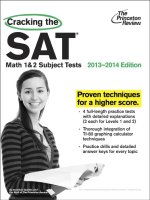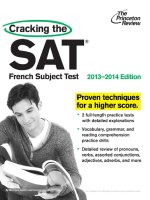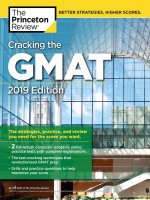Princeton review gre prep 2024
Bạn đang xem bản rút gọn của tài liệu. Xem và tải ngay bản đầy đủ của tài liệu tại đây (48.04 MB, 963 trang )
The Princeton Review Publishing Team
Rob Franek, Editor-in-Chief
David Soto, Senior Director, Data Operations
Stephen Koch, Senior Manager, Data Operations
Deborah Weber, Director of Production
Jason Ullmeyer, Production Design Manager
Jennifer Chapman, Senior Production Artist
Selena Coppock, Director of Editorial
Orion McBean, Senior Editor
Aaron Riccio, Senior Editor
Meave Shelton, Senior Editor
Chris Chimera, Editor
Patricia Murphy, Editor
Laura Rose, Editor
Penguin Random House Publishing Team
Tom Russell, VP, Publisher
Alison Stoltzfus, Senior Director, Publishing
Brett Wright, Senior Editor
Emily Hoffman, Assistant Managing Editor
Ellen Reed, Production Manager
Suzanne Lee, Designer
Eugenia Lo, Publishing Assistant
The Princeton Review
110 East 42nd St, 7th Floor
New York, NY 10017
Copyright © 2023 by TPR Education IP Holdings, LLC. All rights reserved.
Published in the United States by Penguin Random House LLC, New York.
Terms of Service: The Princeton Review Online Companion Tools (“Student Tools”) for
retail books are available for only the two most recent editions of that book. Student
Tools may be activated only once per eligible book purchased for a total of 24 months of
access. Activation of Student Tools more than once per book is in direct violation of
these Terms of Service and may result in discontinuation of access to Student Tools
Services.
ISBN
9780593516959
Ebook ISBN 9780593516966
The $100 discount is valid only on new enrollments in The Princeton Review’s selfpaced GRE course between May 16, 2023 and May 16, 2024. Discount cannot be
combined with any other offer (except referral program) and is available to U.S., Puerto
Rico, and Canada customers only. For specific information on the course, visit
Princetonreview.com/grad/gre-selfguided-course.
GRE is a registered trademark of the Educational Testing Service (ETS). This product is
not endorsed or approved by ETS.
The Princeton Review is not affiliated with Princeton University.
The material in this book is up-to-date at the time of publication. However, changes may
have been instituted by the testing body in the test after this book was published.
If there are any important late-breaking developments, changes, or corrections to the
materials in this book, we will post that information online in the Student Tools. Register
your book and check your Student Tools to see if there are any updates posted there.
Editor: Selena Coppock
Production Editors: Nina Mozes, Emily Epstein White
Production Artist: Lindsey Cleworth
For customer service, please contact ,
and be sure to include:
full title of the book
ISBN
page number
a_prh_6.0_144052297_c0_r0
Acknowledgments
The following people deserve thanks for their help with this book:
Many thanks to National Content Director for the GRE John
Fulmer, and to Kyle Fox.
Special thanks to Adam Robinson, who conceived of and
perfected the Joe Bloggs approach to standardized tests, and
many of the other successful techniques used by The Princeton
Review.
Contents
Get More (Free) Content!
Part I: Orientation
1 Introduction
2 General Strategy
Part II: Practice Test 1
Practice Test 1
Practice Test 1: Diagnostic Answer Key
Practice Test 1: Answers and Explanations
Study Guides
Part III: How to Crack the Verbal Section
3 The Geography of the Verbal Section
4 Text Completions
5 Sentence Equivalence
6 Reading Comprehension
7 Critical Reasoning
8 Vocabulary for the GRE
Part IV: How to Crack the Math Section
9 The Geography of the Math Section
10 What Are Math Fundamentals
11 Math Fundamentals on the GRE
12 Algebra Basics
13 Plugging In
14 Real-World Math
15 Geometry Basics
16 GRE Geometry
17 Math Et Cetera
Part V: How to Crack the Analytical Writing Section
18 The Geography of the Analytical Writing Section
19 The Issue Essay
20 The Argument Essay
Part VI: Answers and Explanations to Drills and
Practice Sets
Part VII: More Practice Tests
Practice Test 2
Practice Test 2: Answers and Explanations
1 Go to PrincetonReview.com/prep and enter the following
ISBN for your book: 9780593516966
2 Answer a few simple questions to set up an exclusive
Princeton Review account. (If you already have one, you can
just log in.)
3 Enjoy access to your FREE content!
Need to report a potential content issue?
Contact and include:
full title of the book
ISBN
page number
Need to report a technical issue?
Contact and provide:
your full name
email address used to register the book
full book title and ISBN
Operating system (Mac/PC) and browser (Chrome, Firefox,
Safari, etc.)
Once you’ve registered, you can…
Take 5 full-length practice GRE exams
Watch nine short videos in which some of The Princeton
Review’s teachers discuss GRE question types and
strategies, and work through practice problems step by step
Access crucial information and advice about the GRE,
graduate schools, and the graduate school application
process
Get a code for $100 off The Princeton Review’s self-paced
GRE course (restrictions may apply)
Check to see if there have been any corrections or updates to
this edition
Look For These Icons Throughout
The Book
PROVEN TECHNIQUES
ONLINE ARTICLES
PREMIUM PORTAL
ONLINE PRACTICE TESTS
APPLIED STRATEGIES
WATCH OUT
ANOTHER APPROACH
GOING DEEPER
TIME-SAVING TIP
STUDY BREAK
ONLINE VIDEO TUTORIALS
Dear Test Taker,
There is a lot of content that could be tested on the GRE.
Virtually all that content is covered in this book.
Therefore, this book is very long.
We set out to create a book with a simple goal in mind: we want you to
achieve the GRE score of your dreams. We’ve loaded this book with
enough practice questions, tests, and discussion about the GRE, so that
nothing you see on test day is going to surprise you. Before you even see
a single question, you are going to be provided with information details
to give you confidence that the GRE is the right test for you to take to
help achieve your career goals.
Over the years, The Princeton Review has learned a lot of important
lessons about preparing to take standardized tests. Those lessons that
pertain to the GRE are in the pages of this book.
We’ve also learned lessons about students such as yourself. And central
to those lessons is that no two students follow the same path to success.
Some of you are going to thoroughly comb through every page, take
every practice test, send questions to our editorial team, and consider
nearly nothing else until test day. If this sounds like you, then you are in
luck. This book is crammed full of practice questions, advice, and
strategies for how to best approach problems. You are going to love this
book. You might even give it a permanent spot on your mantle.
But others of you only have so many hours a day or week to devote to
your studies. You’re going to see a book that is this big, that feels this
heavy, and know you are unlikely to see every page and work through
every question. If this sounds like you, then we have good news. You are
also going to love this book. The opening practice test is a diagnostic,
which is going to give you a good sense of where you are with each
section. The customized 2-, 4- and 6-week study guides are going to help
you evaluate that first diagnostic test and give you a plan for how to
move through this book. The closing practice test here in the book is
going to let you know just how far you’ve come, and what you still may
need to review to maximize your score. You can further monitor your
progress with even more practice tests online in your Student Tools.
In short, we created a book that you can use to maximize your time in
order to maximize your score. We think you’ll love it. But don’t take our
word for it. See for yourself.
Happy studying,
The Princeton Review
Part I
Orientation
1 Introduction
2 General Strategy
Chapter 1
Introduction
What is the GRE? Who makes the test? What’s a good score? The
answers to these questions and many others lie within this chapter. In the
next few pages, we’ll give you the lowdown on the things you need to
know about the GRE.
CRACKING THE GRE
For a lot of people, taking a standardized test such as the GRE usually
brings up a number of emotions—none of them positive. But here’s the
good news: The Princeton Review is going to make this whole ordeal a
lot easier for you. We’ll give you the information you will need to do
well on the GRE, including our time-tested strategies and techniques.
Strategies Galore
In this book, you’ll find The Princeton Review’s
trusted test-taking strategies to help you crack
the GRE.
The GRE supposedly allows graduate schools to get a better sense of an
applicant’s ability to work in a post-graduate setting—a goal that is
unrealistic indeed, considering that the people who take the GRE are
applying to programs as diverse as physics and anthropology.
It’s safe to say that the GRE is not a realistic measure of how well you’ll
do in grad school, or even how intelligent you are. In fact, the GRE
provides a valid assessment of only one thing:
The GRE assesses how well you take the GRE.
Got it? Even so, you still want to do well on the GRE, because you want
grad schools to take you seriously when they consider your application.
With this in mind, you should cultivate several very important skills
when you’re preparing for the test; each of them is attainable with the
right guidance (which we’ll give you), a strong work ethic (which you
must provide), and a healthy dose of optimism. Who knows? Maybe
after working through this book and learning how to crack the test, you’ll
actually look forward to taking the GRE.
So what exactly is this test you’ve heard so much about?
Fun fact: It’s possible your GRE score could
come in handy if you are interested in law
school. Check a school’s admissions page for
more info, as some schools are (or are
considering) accepting GRE scores in lieu of
LSAT scores. Your grad school options may have
opened up even further!
WHAT IS THE GRE?
The Graduate Record Examination (GRE) is a 3-hour, 45-minute exam
that’s used to rank applicants for graduate schools. The scored portion of
the GRE consists of the following sections:
One 30-minute Analysis of an Issue Essay
One 30-minute Analysis of an Argument Essay
Two 30-minute Verbal Reasoning sections
Two 35-minute Quantitative Reasoning sections
According to the official scoring for the GRE, the Verbal Reasoning
sections test your skills on three different types of questions:
Text Completion
Sentence Equivalence
Reading Comprehension
However, in this book we break Verbal Reasoning into four sections by
splitting Reading Comprehension into two categories: Reading
Comprehension and Critical Reasoning. This distinction will become
clearer later on. The Quantitative Reasoning sections measure your
prowess in four areas:
Arithmetic and Number Properties
Algebra
Geometry
Data Analysis
WHY DO SCHOOLS REQUIRE IT?
Even though you will pay ETS $220 to take the GRE, it is important to
note that you are not their primary customer. Their primary customers
are the admissions offices at graduate programs across the United States.
ETS provides admissions professionals with two important services. The
first is a number, your GRE score. Everyone who takes the test gets a
number. It is difficult for admissions committees to make a decision
between a candidate with a 3.0 and a 3.2 GPA from drastically different
schools and in two different majors. A GRE score, on the other hand,
provides a quick and easy way for busy admissions offices to whittle a
large applicant pool down to size.
A few countries outside of the United States,
such as Australia and China, charge slightly
more than $220 for the administration of the
GRE. You can find the most recent pricing at
/>
Applicants could come from all over the world and will certainly have an
enormous range in academic and professional experience. How does one
compare a senior in college with a 32-year-old professional who has
been out of college working in a different industry for the past 10 years?
A GRE score is the only part of the application that allows for an applesto-apples comparison among all applicants.
The second service that ETS provides is mailing lists. That’s right; they
will sell your name. You can opt out, but when you sit down to take the
test, ETS will ask you a whole bunch of questions about your
educational experience, family background, race, and gender, as well as
other biographical data. All of this information goes into their database.
In fact, ETS is one of the most important sources of potential applicants
that many graduate programs have.
Another reason schools require the GRE is that it ensures that most
graduate school applicants are qualified. It helps to weed out the people
who might be considering grad school, but who can’t get their act
together enough to fill out applications. When you ask a program how
important the GRE score is to the application, they may say, “it depends”
or “not very,” and that may be true, as long as your score is in the top
half. If your score is in the bottom half, however, it may mean that your
application never gets seen.
So the GRE may have little relevance to any particular field of study you
might be pursuing, but as long as it helps graduate programs uncover
potential candidates, and as long as it is the only tool available to
compare a diverse candidate pool, the GRE is here to stay.
WHO IS ETS?
Like most standardized tests in this country, the GRE is created and
administered by Educational Testing Service (ETS), a private company
located in New Jersey. ETS publishes the GRE under the sponsorship of
the Graduate Record Examinations Board, which is an organization
affiliated with the Association of Graduate Schools and the Council of
Graduate Schools in the United States.
ETS is also the organization that brings you the SAT, the Test of English
as a Foreign Language (TOEFL), the Praxis, and licensing and
certification exams in dozens of fields, including hair styling, plumbing,
and golf.
TEST DAY
You may take the test at a testing center or, now, at home! The GRE
General Test at home is a safe and convenient option for test-takers who
prefer to test at home and not a test center. There is a lot to know about
what your setup at home should look like (as far as what computer setup
is approved, what tabletop and seating setup is approved). Learn more at
www.ets.org/gre.
For that testing center version of the GRE, which is what the vast
majority of test-takers use, the GRE is administered at Prometric testing
centers. This company specializes in administering tests on computer.
They administer citizenship exams, professional health certifications,
dental exams, accounting exams, and hundreds of other exams on
computer. When you arrive at the center, they will check your ID, give
you a clipboard with a form to fill out, and hand you a locker key.
Despite the fact that they already have your information, you will be
asked to fill out a long form on paper. This form includes an entire
paragraph that you have to copy over—in cursive (they specify this)—
that states that you are who you say you are and that you are taking the
test for admissions purposes. This process will take you about 10
minutes, and you can complete it while you wait for them to call you into
the testing room. The locker is for all of your personal belongings,
including books, bags, phones, bulky sweaters, and even watches. You
are not allowed to take anything with you into the testing room.
When they call you into the testing room, they will first take a photo of
you and, in some cases, fingerprint you before you go in. They will give
you six sheets of scratch paper, stapled together to form a booklet, and
two sharpened pencils with erasers. Then they will lead you into the
room where someone will start your test for you. The room itself will
hold three or four rows of standard corporate cubicles, each with a
monitor and keyboard. There will be other people in the room taking
tests other than the GRE. Because people will be entering and exiting the
room at different times, you will be provided with optional headphones.
What to Take to the Test Center:
1. Your registration ticket
2. A photo ID and one other form of ID
3. A snack
Test Day Tips
Dress in layers so you’ll be comfortable, regardless of whether the
room is cool or warm.
Don’t bother to take a calculator; you’re not allowed to use your
own—just the one on the screen.
Be sure to have breakfast, or lunch, depending on when your test is
scheduled (but don’t eat anything you haven’t tried before). Take it
easy on the liquids and the caffeine.
Do a few GRE practice problems beforehand to warm up your brain.
Don’t try to tackle difficult new questions, but go through a few
questions that you’ve done before to help you review the problemsolving strategies for each section of the GRE. This will also help
you put on your “game face” and get you into test mode.
Make sure to take photo identification to the test center. Acceptable
forms of identification include your driver’s license, photo-bearing
employee ID cards, and valid passports.
If you registered by mail, you must also take the authorization
voucher sent to you by ETS.
Stretch, drink some water, go to the bathroom, and do whatever you
need to do in order to be prepared to sit for this four-hour test.
TEST STRUCTURE
While your test structure may vary, you should expect to see something
like this when you sit down to take the exam:
The first section of the test collects all of your biographical information.
If you fill this out, you will start getting mail from programs that have
bought your name from ETS. In general, this is not a bad thing. If you
don’t want them to sell your name, or you don’t want to spend the time
answering their questions, you can click on a box that tells ETS not to
share your information.
More Online
For tons of information about the GRE, check out
PrincetonReview.com/grad/gre-information
Once all of that is done, you will begin your first scored section, the
essays. The two essays will be back-to-back. You have 30 minutes for
each essay. Immediately after your second essay, you will get your first
multiple-choice section. It may be math or verbal. You will have a 1minute break between sections. Here is the structure of the test:
Section
Time
# of Questions
Biographical Information
+/– 10 minutes
–
Issue Essay
30 minutes
1
Argument Essay
30 minutes
1
Section 1
30 or 35 minutes
20
Section 2
30 or 35 minutes
20
Break
10 minutes
–
Section 3
30 or 35 minutes
20
Section 4
30 or 35 minutes
20
Section 5
30 or 35 minutes
20
Possible Research Section
Optional
Depends
Select Schools/Programs
5 minutes
Up to 4
Accept Scores
1 minute
–
Receive Scores
1 minute
–
Here are some things to keep in mind:
You will see five multiple-choice sections, but only four will count.
The fifth will either be mixed in with the other sections as an
unidentified “experimental” section or as a final, identified
“research” section.
Math sections are 35 minutes. There are 20 math questions in each
section. If your experimental section is math, your test will be five
minutes longer than someone whose experimental section is verbal.
Verbal sections are 30 minutes. There are 20 verbal questions in
each section.
For the computer-delivered test, the optional 10-minute break comes
after the second multiple-choice section. For the paper-based test,
the 10-minute break comes after the second Analytical Writing
section.
You may or may not get a research section. If you do, it will come
last; it does not count toward your score, and it is optional.
You must accept your scores and, if you choose, send your scores to
selected programs prior to seeing your results.
If you choose not to accept your scores, neither you nor any program
will ever see them.
You may choose to send your scores to up to four graduate programs
on the day of the test. This service is included in your testing fee.
A Note on the Paper-Based GRE
The computer-delivered GRE is the standard
format for test takers. The paper-based GRE is
far more rare and offered up to only three times a
year. But if you want to learn more about the
paper-and-pencil test, visit ETS.org.
The Experimental Section
ETS administers the experimental section to gather data on questions
before they appear on real GREs. Because there are only two scored
Math sections and two scored Verbal sections, you’ll know by that last
section whether the experimental section is math or verbal. However,
you will have no way of knowing in advance which multiple-choice
section is experimental, so you need to do your best on all of them. Don’t
waste time worrying about which sections count and which section does
not.
Research Section
Instead of an experimental section, you may find that the last section of
your test is marked as an unscored research section. This section is used









